Listening to the market, listening to customers, and adapting is important – we all operate in a very competitive market. For any offer – there are the classic “four P’s” that a team needs to consider, and VxRail nails them.
1. Pricing – starting at $60K list. This is particularly important in a market which is all about “starting small, and scaling up”.
2. Product – modern hyper-converged offers need all flash. They need dedupe. They need compression. They need real erasure coding. They need flexible configurations. They need rich local and remote replication. They need cloud object storage integration and local NAS support. They need to make “day 2” operations single-click simple.
3. Positioning – anyone who says that one converged or hyper-converged offer can cover every use case is (IMO) as high as a kite, or suffering from “single product delusion”. Reality? Some customers can get away with one product for all workloads and scales (for them). Most need more. Most need:
a. Vblock to cover the enterprise datacenter with the most traditional workloads.
b. VxRack to cover the enterprise datacenter when a customer wants to scale BIG, and “don’t worry about the network” is tantamount to planning for failure.
c. VxRail, which is built to start small, and scale.
d. VxRail, which is ideal for SMB, SME – heck with 64 nodes in 16 appliances – it can run 3000+ VMs and could run many enterprises.
e. VxRail, which is unbelievable at the enterprise edge – where extending their standards from the datacenter, integrated management, simple workload mobility – is powerful.
4. Packaging – people who understand technology and innovation as ultimately powering business understand this is important.
a. Only VxRail has been developed by VMware and EMC operating with a single product team – for this release, for the Q2 update, for what we have in Q3, and for everything afterwards.
b. Only VxRail is a hyper-converged appliance with a single support model for everything inclusive of the VMware software. VSAN-ready nodes can of course have a single support stack for VSAN and the hardware it runs on, but a hyper-converged appliance is more than hardware + an SDS stack.
c. Only VxRail has integration with VxRack and Vblock to deliver a full enterprise solution for all workloads, all leveraging VCE Vision, and the ability to replicate and protect from the enterprise edge to the datacenter, and for all workloads. And what we’re delivering in Q1 only will get stronger.
A portfolio matters – as no customer is the same, unless you are a hammer – in which case everything looks like a nail.
EMC is the CI leader. Gartner says it. IDC says it. But forget those guys. What’s more important is that the most important people – the customers say it. They say it to the tune of a $3B+ annualized run rate. That said – so far, it’s all been in the “converged infrastructure” (what Gartner calls “Integrated Infrastructure Systems” in their taxonomy).
What’s going on there? Well, we have a ton of happy customers using Vblock broadly – for a ton of data center workloads, including the most classic, the most traditional workloads. When you are operating at material scale, when you have workloads that don’t scale CPU/storage together, sometimes converged infrastructure is the way to go – and Vblock leads the way, and we continue to innovate and improve. EMC and Cisco keep doubling down in that domain. Are we perfect? No. Do we respect the competition? Do we listen to customers? Do we always strive, fight, and improve? Yeah. Anyone who thinks they are not in a position to be disrupted is arrogant and delusional.
Interestingly, perhaps our biggest challenge is that Vblock is the “Kleenex” of converged infrastructure – and that people need to know what we are doing in hyper-converged system architectures. Heck people call things “Vblocks” when they mean “converged infrastructure” (lol – sometimes calling Cisco UCS attached to anything a “Vblock”). Well, the market won’t be able to be unaware of our innovation and leadership in hyper-converged systems much longer.
We have VxRack customers for data center workloads where a hyper-converged scale-out model is superior. And, to be clear, when you are deploying hundreds of nodes at once, I personally would run (not walk) from anyone who didn’t take a full system design that incorporated the ToR switches and Spine/Leaf network architecture (and that enables you to scale to hundreds and thousands of nodes – not deployed in small “clusters”, but as a massive scale-out rack-scale, web-scale, and hyper-scale system). There are customers who are investing in VxRack that are single customers that drive hundreds of nodes – and growing. For relative measure – some of these customers are spending – in a single transaction – with us the equivalent of ~1/20th of the annual revenues of the hyper-converged “unicorns”… and VxRack is accelerating fast.
What we lacked was a strong offer that covered a critical gap – the ability to start really easily, really small – and then be able to scale up.
That’s critical for the enterprise edge and remote office/branch office. It’s critical for customers who can run their datacenter on hundreds or thousands of VMs. And that “start small, really small” was something we didn’t have, and our earlier attempts didn’t get right. With VxRail we have it, and we think we have nailed it.

In 2015, the VMware and EMC teams took stock of what we had learned about this market.
-
- • We learned that the customers love vSphere, love VMware, and it has become (for many customers – not all) their standard. While there’s great heterogeneity in the Enterprise Datacenter (where Vblock and VxRack play strongly as heterogeneous platforms), in many markets (by segment and by use case) – VMware is their standard – period.
- • We learned that trying to design software and hardware separately didn’t work. You ended up with configurations that were too fixed, not sufficiently integrated, and an ability to innovate in both domains that was constrained (software that lagged, hardware that lagged, just due to a complex co-engineering model).
- • We learned that customers wanted far, far more flexibility than we originally thought. We thought that simplicity (single part/single type of node) was paramount. The customers corrected us. They wanted simplicity sure, but they also wanted more. They wanted flexibility in configurations. They wanted flexibility in maintenance and support (versus a fixed 3 year support model). They wanted to bring their existing ELAs to the party.
- • We learned that there was a critical set of features and capabilities that if you don’t have – you’re just not competitive.
So – we brought together the VMware and EMC teams and made them one.
Literally, the VxRail team is single organization, completely integrated – who have now delivered more than 200,000 engineering hours together – and are only getting started.
Their charter, their mission is simple: build, deliver, and iterate to create the market’s leading hyper-converged infrastructure appliance. To build an offer for customers who have made vSphere their standard – and to make it the simplest, easiest system to deploy, scale and maintain.
VxRail is that offer – and is a quantum leap forward, the first of several quantum leaps for 2016.
VxRail integrates with VxRack and Vblock for a full converged/hyper-converged portfolio that is without peer.
Of course – while VxRail is something unique to VMware and EMC and our only Hyper-Converged Infrastructure appliance offer, it’s important to recognize that VMware maintains an open ecosystem for hyper-converged software elements – vSphere, VSAN, VSAN-ready nodes. That is important – customers want choice. And of course, some other folks are absolutely welcome to build on top of VSAN ready nodes and add their own value.
But – when you want a turn-key appliance solution, VxRail is the answer from VMware and EMC.
There will certainly be naysayers. There will certainly be some that point to past efforts (you live, you learn, you adapt, and you iterate forward). I’m SURE that competition will pile on – and we respect them all (the large and the small) a great deal.
Ultimately – the only proof is in what the customers and the market says but I’ll reinforce my personal point of view:
-
- Customers need a portfolio that covers their full spectrum of use cases, inclusive of blocks, racks, and appliances.
- Customers want partners with them for the long haul.
- Customers want partners who can provide solutions that run above the converged/hyper-converged infrastructure stack – full turnkey IaaS, PaaS, and data fabrics.
- Customers want partners who understand that technology and innovation is critical, but also that support, maintenance and thinking about the big picture is a pre-requisite. Uniquely, and I want to be clear here – while there can be ecosystem support models for hardware and software in things like VSAN-ready nodes – when it comes to a full appliance experience – the simplest, easiest model – with full single support – is VxRail. Full stop.
Let me fill you in a little more re technical details of VxRail. Read on!

The first thing to understand is we classify VxRail as an appliance – with a picture, above!
When we say “appliance” that means totally turnkey, with a “bring whatever rack and networking infrastructure you have” type of offer.
It also means modular scaling in building blocks. This is the more common hyper-converged offer that people think of today, and I think (?) that for example everything that Gartner has in the Hyper-Converged Infrastructure System (HCIS) segment falls into this bucket. “Start small, scale and update easily” is the mantra.
It is distinct from what we would classify as a “Hyper-Converged Rack Scale System”.
This “Rack-Scale” part of the system taxonomy is not as well defined. If “start small, scale and update easily” is the mantra from appliances, then for this class of solutions “scale BIG, scale and update easily” is the mantra at Rack-Scale. Rack-Scale systems must incorporate the network fabric as a core part of the system design and management stack (which means they start bigger than appliances), and commonly use a much wider set of hardware, often in “disaggregated” or “composable” infrastructure designs. Note that you can’t just “bundle” the network – it needs to be part of the system – with single support, lifecycle, warranty – and of course management integration – i.e. everything that goes with the networking domain being integral. None (!) of the Hyper-Converged Appliance offers does that. VxRack is that type of system – but that’s a story for another day.
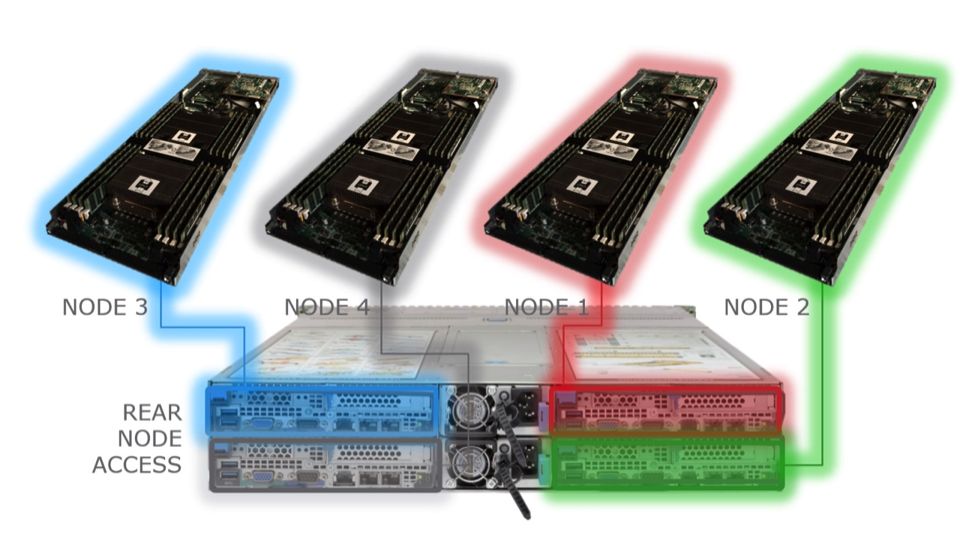
When you look at VxRail, it uses (for now, we will continue to expand this over time) the very popular 2U4N (2U form factor, 4 module) form factor – and ultimately will be able to start with 3 nodes, and scale in 1 node increments.
That’s a lot of power in a small package (as I keep telling people – should never, ever be underestimated 🙂 ) Think 112 CPU cores. Think 2TB of DRAM. Think 76 TB of NAND flash. Think 8 10GbE ports – for more bandwidth than can be imagined.
This thing can scale – and frankly support a ton of workloads.
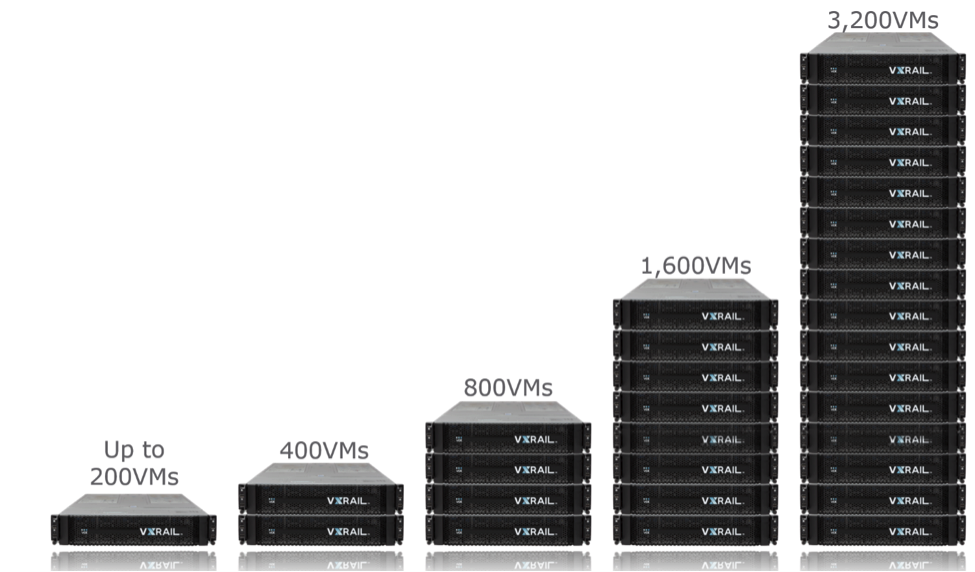
With 16 appliances (which translates to 16×4 nodes = 64 nodes) a scaled up VxRail cluster could support 3000+ VMs, with millions of IOPs and 1.2PB of all-flash capacity, raw (before we apply dedupe and compression). That’s a lot of oomph. BTW – if you KNOW you’re going to scale that big, you’re better off to start thinking about rack-level scaling, pre-plan the spine-leaf network and consider a VxRack to start. But – if you’re not sure – no worries, start small and grow.
Now, when I said that we learned that customers wanted more configurability, I meant it.
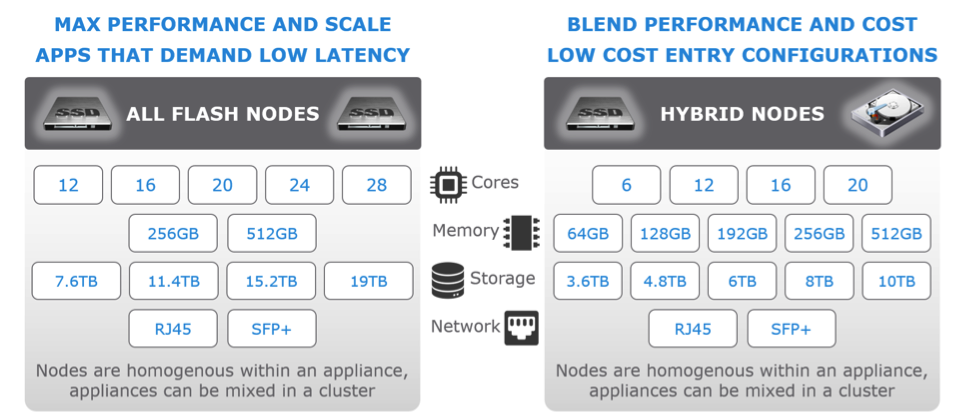
Ultimately this configurability manifests in the following hybrid models:
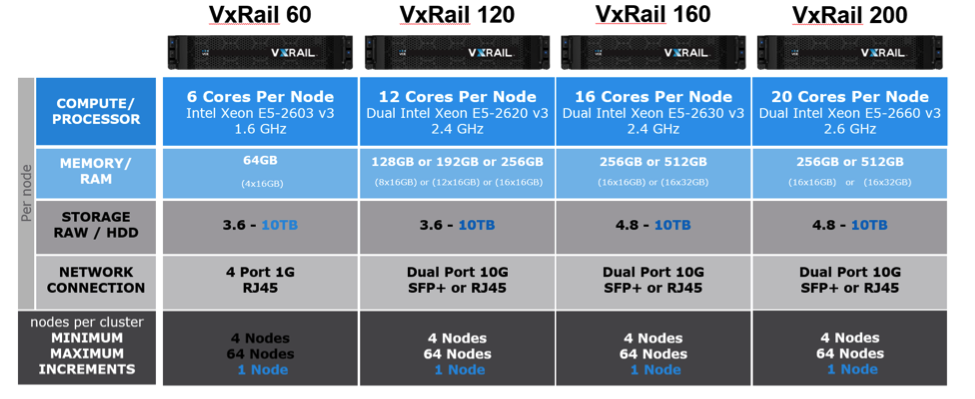
… and the following all-flash models:
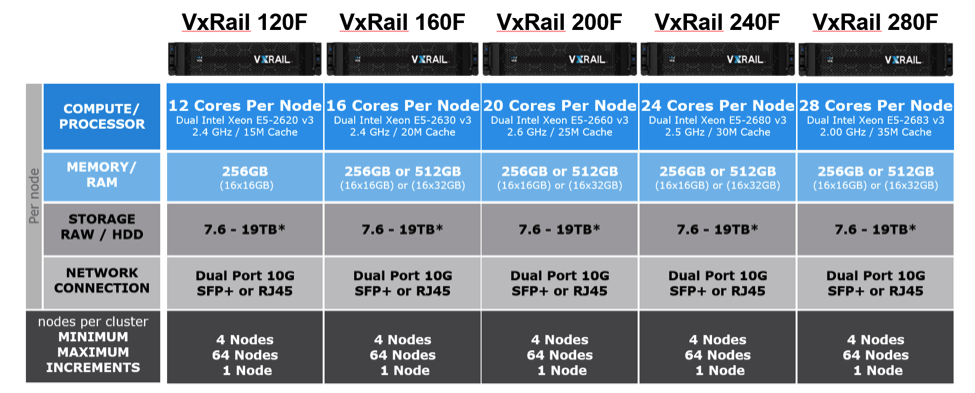
Not all the models GA at the same time (some almost immediately here in Q1, some arrive a little later in Q2), and there will be a series of software updates (to all configurations – including VSPEX Blue customers) that add features and functions – always non-disruptively.
Now – I personally think that the all-flash models will be preferable to hybrids. I think we’ve reached the tipping point that for any transactional workload (and VMs are transactional workloads), all-flash configurations are the sweet spot – not only because the dedupe, compression and other data reduction features are designed for flash, but simply because we have hit the inflection point, where there are no reasons NOT to go all-flash (power, cooling, IOps, latency, bandwidth, predictability, lower failure rates – all lean to all-flash). This is true of external SAN models (XtremIO, all-flash VMAX), but it’s also true of transactional SDS-based configurations too.
A huge part of any hyper-converged infrastructure appliance is the SDS layer – because in material ways, it defines the system behaviors and envelopes.
VxRail is a natural extension for customers who have said “look, vSphere is our standard”. When you are focused on vSphere and vSphere uniquely, VSAN is the strongest SDS – bar none (and when you need more heterogeneity, things like VxRack and Vblock are the right answer).
Virtual SAN 6.2 is face-meltingly awesome, and to understand what it can do – you should read this.
Ok… You back? Great – now you understand the power of all the new all-flash leverage, the data reduction capabilities, the inherent advantages of a kernel-integrated SDS target code layer and more.
But – what about if you wanted some NON-TRANSACTIONAL storage? What if you needed some NAS for CIFS shares, or NFS (general purpose, or for an NFS-based data store)?
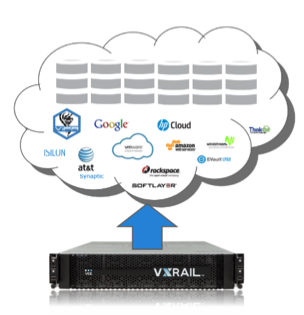 Well – historically, one downside of hyper-converged appliances is that for capacity-oriented, non-transactional scenarios – frankly, they haven’t been too hot. Hard to get the right density, relative to compute, and certainly compared with non-hyper-converged design points (like ultra-dense storage
Well – historically, one downside of hyper-converged appliances is that for capacity-oriented, non-transactional scenarios – frankly, they haven’t been too hot. Hard to get the right density, relative to compute, and certainly compared with non-hyper-converged design points (like ultra-dense storage
arrays).
So, we thought creatively – and day one, VxRail can leverage almost any S3-compliant cloud object store for cold VMs, Archives, as well as any general purpose NFS, CIFS or iSCSI storage needs – and every single appliance comes with a 10TB license. You heard right. 10TB license – and you just need to provide a cloud object store.
Of course – this can be any object store.
If you’re worried about security, it’s all encrypted, and compressed. Not good enough? Then use the best, most cost-effective S3-compliant (plus a whole heck more) object store of your very own – Elastic Cloud Storage (ECS).
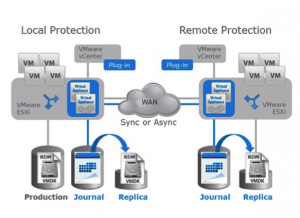 What about the question of local and remote replication? Surely VxRail, like most HCIA offers has the same somewhat limited set of data services in this regard – long RPO async (minutes) generally as the watermark? Nope. How about incredible enterprise-class replication technology, inclusive of consistency groups, VM-level replication, sync, low-RPO async, continuous replication – and of course with great simple ease of use, and the industries best compression and deduplication across the WAN? RecoverPoint for VMs is included (licensed for 15 VMs per appliance – and you can easily add more), and completely integrated in the UI VMware administrators call home – the vSphere Web Client.
What about the question of local and remote replication? Surely VxRail, like most HCIA offers has the same somewhat limited set of data services in this regard – long RPO async (minutes) generally as the watermark? Nope. How about incredible enterprise-class replication technology, inclusive of consistency groups, VM-level replication, sync, low-RPO async, continuous replication – and of course with great simple ease of use, and the industries best compression and deduplication across the WAN? RecoverPoint for VMs is included (licensed for 15 VMs per appliance – and you can easily add more), and completely integrated in the UI VMware administrators call home – the vSphere Web Client.
What about rich data protection – that integrates with what the customers already have, versus forcing new backup models on the customer?
VxRail has embedded data protection, but can also replicate to other VxRail appliances. But what’s even better is that for customers with larger datacenter requirements that have selected the leader in the purpose-built data protection platform, Data Domain – VxRail has turn-key integration with Data Domain that enables simple point and click backup and recovery that leverages DDBoost to offload the network, dedupe all the content, and make it simple to have “edge <-> core” data protection that is simple and just works. No other hyper-converged appliance does that.
What about simple stretched clusters over short distances? Check.
Net?
VxRail:
-
- Extends your standard. If you’re using VMware, and you’re a small/medium business, a small/medium enterprise (remember 3000+ VMs can run many a datacenter!) or a large enterprise with edge/ROBO locations – look no farther.
- Is ridiculously simple.
- Starts really small ($60K list).
- Scales really big (64 nodes!).
- Scales and does all “day 2” operations with the click of a button.
- Performs better than any other HCIA on the market.
- Rocks and rolls in all-flash configurations, and man, in 2016 – why not go all-flash?
- Has rich data reduction services (dedupe, compression)
- Has efficient erasure coding that saves you money, and doesn’t have all sorts of caveats.
- Has unique abilities to leverage cloud object storage, add local NAS
- Can extend your standards from edge to your core:
- For Support/consumption/health integration with VCE Vision (just like VxRack and Vblock) – an area we will keep doubling down on.
- For disaster recovery (with enterprise-class replication capabilities like consistency groups, sync/async/continuous RPOs, VM-level protection, single click integration with your STANARD management UI (vSphere web client).
- For backup – leveraging your existing standards, and not forcing new backup investments. If you have Data Domain, it just snaps right in.
While today is all about VxRail, in the end, with EMC and VMware – it’s about a portfolio – and ultimately, there is NO other Converged/Hyper-Converged Infrastructure provider who could actually deliver on the picture below.
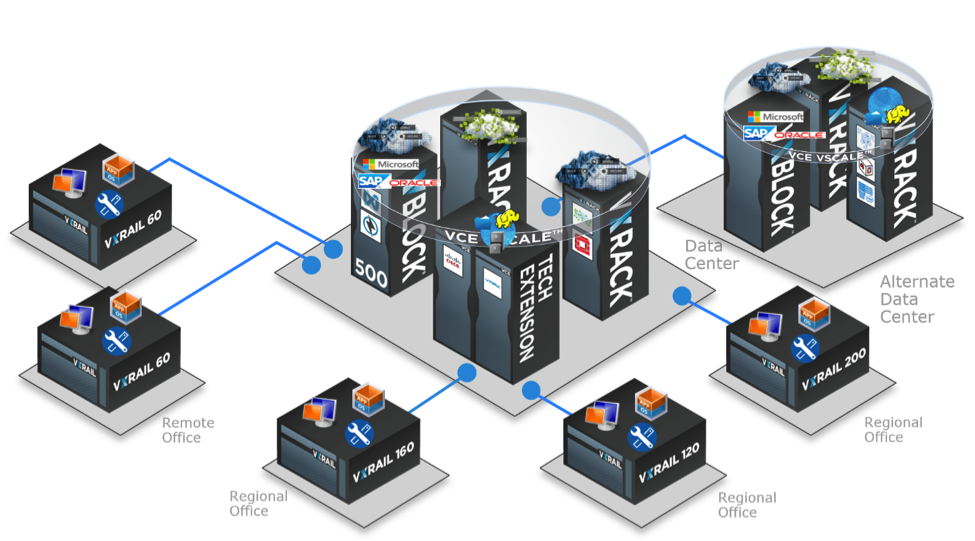
Now, as always. Are we perfect? And – to be clear – that extends to the whole picture above. No. Do we respect the competition, do we listen to the customers, do we always strive, fight, and improve? Yeah.
I know the EMC team (inclusive of VCE as the Converged Platforms division) and we have a passion for the customer. The whole team and I will keep fighting, keep pushing to improve on all fronts with our customers front and center in our mind.
In fact, the voice of the customer and the partner is always the most powerful – and the right way to end this post. Consider these examples – and to a one, these are people who have broad industry experience with not only our technologies, but with the industry broadly (including our competition).
The voice of a partner: “The addition of VxRail into the VCE product family will allow us to now provide our customers with a comprehensive portfolio of converged systems for almost every use case– vBlock and VxBlock for Tier 1 workloads, VxRack for Tier 2 dev/ops environments, and now VxRail as the ideal remote/branch office offering. “
The voice of a customer: “VxRail offers us real choice; we can scale from our trackside environment to a complete data center solution all from one vendor.
Our trackside infrastructure travels around 75,000 miles per season, supporting Renault Sport Formula OneTM Team with continuous IT services at every race worldwide. The small footprint of the VxRail is desirable because our infrastructure must work in extreme temperatures, limited space and other challenging conditions. We are also pleased with the solution’s ability to support our critical workloads and the masses of data generated each week without any compromises on availability, power, and speed.
I can already appreciate the cost and time-saving benefits we could gain by deploying a condensed, self-contained, standard 2U hyper-converged rack using best of breed storage and compute technology. For trackside, the savings in freight charges alone would be approximately $200,000 per season, and the simplified set-up of VxRail means we could be up and running much quicker at every race, offering a significantly improved user experience.
Hyper-converged infrastructure offering continuous availability, speed of access and time-saving features, and all in a self-contained 2U package which just works – VxRail’s pretty smart.”
– Antony Smith, Renault Sport Formula One, IS Infrastructure Manager
And that all says it more than I could.
Thank you and congratulations to the VxRail team for this great day – and I know that while you’ll briefly celebrate, I also know your passion to be awesome, and you’ll be right onto the next software update right away (which all VxRail customers will get gratis, and will be able to apply non-disruptively).
Thank you dear readers, partners, customers – and as always, input welcome! Where do you want us to go together next?
Forward-Looking Statement Legend
This release contains “forward-looking statements” as defined under the Federal Securities Laws. Actual results could differ materially from those projected in the forward-looking statements as a result of certain risk factors, including but not limited to: (i) risks associated with the proposed acquisition of EMC by Denali Holdings, Inc., the parent company of Dell, Inc., including, among others, assumptions related to the ability to close the acquisition, the expected closing date and its anticipated costs and benefits; (ii) adverse changes in general economic or market conditions; (iii) delays or reductions in information technology spending; (iv) the relative and varying rates of product price and component cost declines and the volume and mixture of product and services revenues; (v) competitive factors, including but not limited to pricing pressures and new product introductions; (vi) component and product quality and availability; (vii) fluctuations in VMware, Inc.’s operating results and risks associated with trading of VMware stock; (viii) the transition to new products, the uncertainty of customer acceptance of new product offerings and rapid technological and market change; (ix) risks associated with managing the growth of our business, including risks associated with acquisitions and investments and the challenges and costs of integration, restructuring and achieving anticipated synergies; (x) the ability to attract and retain highly qualified employees; (xi) insufficient, excess or obsolete inventory; (xii) fluctuating currency exchange rates; (xiii) threats and other disruptions to our secure data centers or networks; (xiv) our ability to protect our proprietary technology; (xv) war or acts of terrorism; and (xvi) other one-time events and other important factors disclosed previously and from time to time in EMC’s filings with the U.S. Securities and Exchange Commission. EMC disclaims any obligation to update any such forward-looking statements after the date of this release.